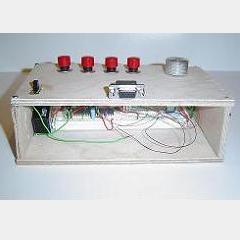Categories
- animatronics (12)
- apple (11)
- arduino (179)
- art (41)
- articles (121)
- artificial intelligence (11)
- automation (421)
- avr (205)
- bitcoin (3)
- breadboard (9)
- cameras (57)
- cars (26)
- cell phones (28)
- clothing mods (21)
- console mods (26)
- dangerous (94)
- desktop mods (24)
- embedded (5)
- flying things (54)
- fpga (22)
- gaming creations (108)
- interface (225)
- internet (17)
- laptop mods (6)
- lasers (22)
- linux (7)
- magnetic (3)
- medical (12)
- microcontrollers (51)
- misc projects (152)
- msp (12)
- music (124)
- pic (90)
- projects (23)
- pyroedu (76)
- raspberry pi (26)
- robots (312)
- security (36)
- sensors (307)
- software (200)
- solar (19)
- stamp (9)
- tools (149)
- tutorials (98)
- Uncategorized (45)
- usb (44)
- wireless (256)
Sponsors


Posted December 4, 2007 by Chris
The stepper motor offers a different type of mobility than DC motors. If your project needs to travel at precise speed or distance then stepper motors are your easy-to-implement answer!

Posted November 25, 2007 by Chris
Using development boards for prototyping is great for beginning, however there comes a time when you need to learn how to design your own circuit for your own board.

Posted November 16, 2007 by Chris
Servo motors offer two things a DC motor rarely can: Torque & Precision. Learn how to use the PIC to control servo motors so you can include them in your next project!

Posted November 5, 2007 by Chris
The Wooden Menace is a robotic arm made from hobby servos & (you guessed it) wood! It can be autonomously or remotely controlled.

Posted October 25, 2007 by Chris
If you want your next project to be mobile, being able to reliably control motors is a must. In this tutorial, we use the LMD18245 to control a simple 12v DC motor.

Posted October 14, 2007 by Chris
Expanding upon the previous tutorial where we learned how to connect a PIC to a host computer, we are now ready to actually program the PIC. This tutorial explains that process.

Posted September 26, 2007 by Chris
The Test Box is a primitive VGA controller that uses a µController and runs at 4 MHz. The µController outputs VGA signals; the monitor receives them & displays what is sent.






